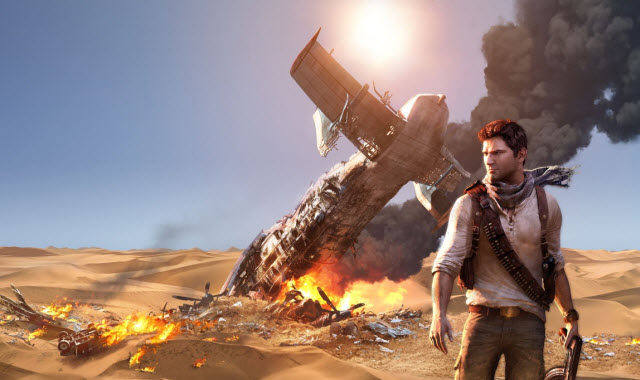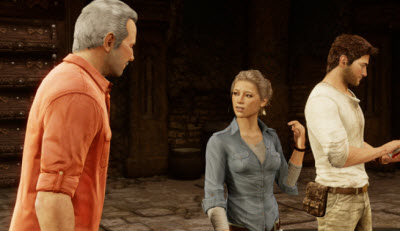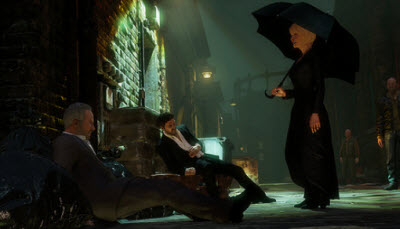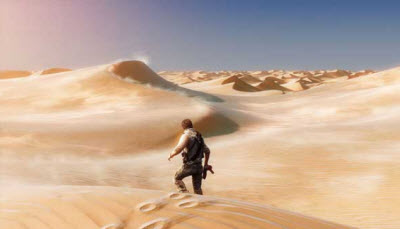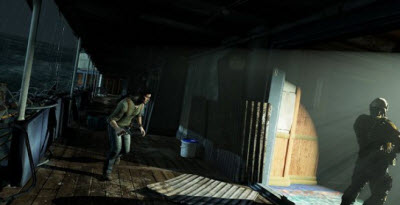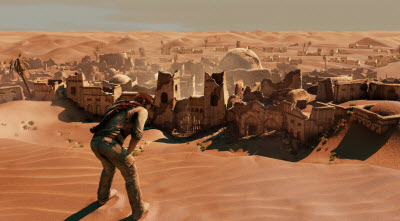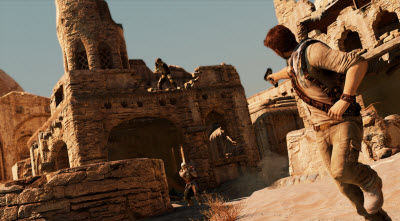Editor’s note: This review contains some story spoilers.
Uncharted 3: Drake’s Deception is one of the best video games of the year. In fact, it is one of the best I’ve ever played. But it will also go down as one of the most annoying.
On the good side, developer Naughty Dog has perfected the art of building a video game experience that mimics the thrills of a blockbuster summer action movie. But that description doesn’t do the game justice, as its story, dialogue, voice-acting, humor and character development are just so much better than anything you’ll ever see in an Indiana Jones movie.
Within Sony’s arsenal of exclusives for its PlayStation 3 business, Uncharted is the crown jewel, the game that could keep Sony fans loyal no matter how many Halo or Mario games come out from the other guys. I just wish that Naughty Dog would polish this jewel a little bit more. The game comes out on Tuesday.
The dreamers of the day
No flaws are evident in the beginning. From a starting quote by T. E. Lawrence (“the dreamers of the day are dangerous men, for they may act their dreams with open eyes, to make it possible”), author of Lawrence of Arabia, to the beginning of the real action nearly four chapters later, the introductory sequence is impeccably done. The dramatic pace yields maximum tension and mystery. Humor offsets epic events. You don’t even pick up a gun and start shooting until a long introductory sequence has played out. This beginning, told with skillful flashbacks and flash forwards to the present day, shows that the developers would be in good company among master filmmakers like the Coen brothers.
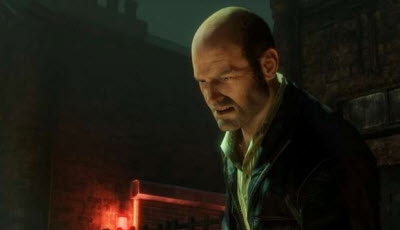 The subtitle about deception is a theme that is woven into many threads in this story. As the game begins, a cinematic — or a pre-scripted film-like sequence — volleys us into that theme. Drake stages a ruse to figure out who is pursuing his family ring, which belonged to explorer Sir Francis Drake. Nathan thus stumbles upon his old nemesis Katherine Marlowe, and some kind of secret society that has been pursuing Drake’s secrets for 400 years, and we meet a new character, Charlie Cutter (pictured right), a likable con artist and thief with a thick English accent and a proclivity to switch sides. That sets the game in motion.
The subtitle about deception is a theme that is woven into many threads in this story. As the game begins, a cinematic — or a pre-scripted film-like sequence — volleys us into that theme. Drake stages a ruse to figure out who is pursuing his family ring, which belonged to explorer Sir Francis Drake. Nathan thus stumbles upon his old nemesis Katherine Marlowe, and some kind of secret society that has been pursuing Drake’s secrets for 400 years, and we meet a new character, Charlie Cutter (pictured right), a likable con artist and thief with a thick English accent and a proclivity to switch sides. That sets the game in motion.
As the deceptions multiply, you as Drake have to consider whether you can really trust those close to you, and if you can trust your own mind from deceiving you. I also had the added experience of being sick with the flu for most of the time that I played the game, and I had to deal with my mind playing tricks on me. As Drake struggled through his own journey of delirium in the game, so did I, in a heavily medicated state.
I imagined, for instance, that I played the game for more than 20 hours, when it was more like 15. As I played the game over multiple days and nights, images from Uncharted 3 invaded my dreams and nightmares. Like Drake, I couldn’t get those damn spiders out of my head. Still, I didn’t mind that, as I could do worse than to ingrain my brain with imagery from Uncharted 3.
Visual arrest
As with Uncharted 2, the art style is artificially vibrant. All of the images are fairly realistic. But the colors of the environment are sharper and brighter than you would ordinarily see in real life, as if you were looking at life through the lenses of the best nature photographers. This effect is so well done that you’ll spend time just marveling at the detailed objects that are part of every colorful scene. Like when you jump to a wire and a pigeon flutters off of it.
Drake has an uncanny, parkour-like ability to climb walls as if he were a monkey, a skill that we learn in this game goes back to his childhood. The colors, pipes, and bars always give away the parts of the environment that offer a path for Drake to climb his way out of a tough spot. It also allows you to study the environment and pick out clues that stick out like a sore thumb, like yellow bricks or pipes for climbing. In this way, the colors affect the game play.
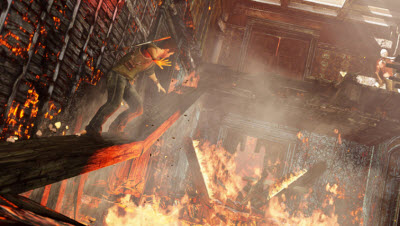 They can also bring game play to a momentary standstill. When you’re on a city rooftop, you can pause for a moment and see a gorgeous skyline for miles and miles. Uncharted 3 is simply one of the prettiest games you’ll ever see. There are so many beautiful moments in this game, like sand billowing through the desert, light breaking through a green forest in France, gun battles in the middle of a sandstorm, light coming through the stained glass of a French château, and that château going down in flames as Drake and his body Sully try to escape a conflagration. You haven’t seen bright orange until it fills your entire screen as you look down while Drake is dangling by one arm from a staircase, looking down on the maelstrom below.
They can also bring game play to a momentary standstill. When you’re on a city rooftop, you can pause for a moment and see a gorgeous skyline for miles and miles. Uncharted 3 is simply one of the prettiest games you’ll ever see. There are so many beautiful moments in this game, like sand billowing through the desert, light breaking through a green forest in France, gun battles in the middle of a sandstorm, light coming through the stained glass of a French château, and that château going down in flames as Drake and his body Sully try to escape a conflagration. You haven’t seen bright orange until it fills your entire screen as you look down while Drake is dangling by one arm from a staircase, looking down on the maelstrom below.
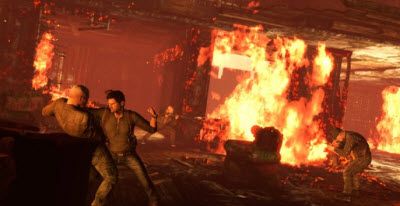 Some of the most strikingly memorable images are the sparkling eyes of the characters as they stare directly into the camera. That’s where you begin to wonder if these video game characters have their own souls, as they can deliver so much emotion through their eyes. Some of these moments are cinematic, and some occur in live game play. The cool thing is that they blur into one, so you can’t tell if you are playing a game or watching a movie. Naughty Dog creates lots of tiny little animations that lend realism to Drake’s motions, and it usually finds a way to view any scene in the most cinematic way, like when you’re trailing Sully from above and can still see his movements on the street and your own moves on a balcony high above him.
Some of the most strikingly memorable images are the sparkling eyes of the characters as they stare directly into the camera. That’s where you begin to wonder if these video game characters have their own souls, as they can deliver so much emotion through their eyes. Some of these moments are cinematic, and some occur in live game play. The cool thing is that they blur into one, so you can’t tell if you are playing a game or watching a movie. Naughty Dog creates lots of tiny little animations that lend realism to Drake’s motions, and it usually finds a way to view any scene in the most cinematic way, like when you’re trailing Sully from above and can still see his movements on the street and your own moves on a balcony high above him.
The uncanny graphics were one of the attractions that got my eldest daughter to play the game with me. She would never otherwise play a shooter game, but Uncharted is so much more than that and its many temptations drew her in. Her presence helped me get through it. When I conked out from the flu, she took over. On our first run through, she handled the puzzles that my addled brain couldn’t, while I handled the twitch-based shooting battles that were too much for her. But on the second run, she made me into the passenger.
A sense of humor
Besides the visual senses, the other sense that Uncharted 3 tickles is humor. The game retains that wonderful deadpan sense of humor that Uncharted 2 had. The enemies never joke around. They exist only to be mean and to be shot. But humor is what sets apart our band of thieves, and it distinguishes the game from most other overly serious games in the industry.
Early on, Sully says, “Then we track them back to their hole.” And Drake responds, “You do realize you make everything seem so dirty?” At one point in an abandoned French château, Drake sees an ornate red cabinet and asks, “Is that a popcorn machine?”
The game’s self-referential humor is always there. Drake always has to ask Sully for a light, as they pass through tunnels and caverns. Sully says, “You know, one of these days you’re going to have to start carrying your own matches.”
Drake banters with the other characters like Charlie and Chloe. The previous game dwelled upon some rivalry between Chloe, who looks more like a typical buxom video game heroine from the industry’s traditionally sexist view of women, and Elena (pictured above), who is uniquely normal (non-busty) female character but pretty in a Jennifer Aniston sort of way.
But the banter with Sully (pictured above, left) is always the best. And the story makes it clear early on that Drake’s relationship with Sully is one of the main story paths in the game. The story takes you back in time to a point where they both developed a mutual respect for each other, which continues to be the foundation for their father-son-like relationship. Together, they’re always seeking treasure.
Taking creative risks with stories
In 2006, the first game, Uncharted: Drake’s Fortune, introduced treasure hunters Nathan Drake and Victor “Sully” Sullivan as they seek the lost city of El Dorado. They are accompanied by journalist Elena Fisher and run into rival pirates as they seek their fortunes. The title sold reasonably well with the launch of the PlayStation 3, but it was overshadowed by Resistance: Fall of Man and it was mocked as “Dude Raider,” or a male version of the Lara Croft Tomb Raider series. It earned an average 88 out of 100 rating on Metacritic, which aggregates review scores.
In 2008, Uncharted 2: Among Thieves debuted as a masterpiece in game play and storytelling. In search of the lost valley of Shambala, Drake is rejoined by his pal Sully and Elena as well as the new character Chloe Frazer, a thief. The two women are fierce fighters who love Drake but don’t want to admit it and compete for his attention. Naughty Dog pulled everything off so well that the game was almost universally acclaimed as the best of the year. We named it the best game of 2008 and it earned an average rating of 96 out of 100 from Metacritic.
In the new game, we meet a new and intriguing foe, Katherine Marlowe, who has some history with both Drake and Sully. Drake sets her up right when he cracks, “Aren’t you afraid you’ll melt?,” when she closes her umbrella (a reference to the cackling Wicked Witch of the East from the Wizard of Oz). Marlowe cackles and dishes venom right back at Drake. Her assistant Talbot is a model in polite and cold-blooded efficiency.
While Marlowe plays a good villain, the most interesting character this time around is Drake himself. He is always striving upward, like the inscription on the ring, which translates to, “Great things from small beginnings.” His story starts as a treasure hunt, but it becomes more than that, as he has to deal with inner demons and these damn spiders everywhere.
The literary effect
Uncharted 3 becomes more epic as its story takes historical and literary turns. Like in the Da Vinci Code, the history of Drake’s travels intersects with Sir Francis Drake’s missing months from his diary. Many have tried to figure out what Drake did during this time, and T. E. Lawrence, the historical figure from the Arab rising and a great archaeologist as well, was among them. Drake finds out that Lawrence was searching for a lost city known as The Atlantis of the Sands, also known as Iram of the Pillars or Ubar — an ancient city destroyed by a natural disaster. Drake’s discoveries on top of what Lawrence knew lead him to France, Syria, and modern-day Yemen. There, he confronts the Rub’ al Khali, the giant desert that appears at the beginning of the game.
It is within the Rub’ al Khali that Drake has his brush with inner madness. As Drake wanders the desert, he hears the villain Marlowe recite lines from T.S. Eliot’s classic poem, The Wasteland. “What are the roots that clutch, what branches grow out of this stony rubbish?” It closes with, “I will show you fear in a handful of dust.”
For me, the passage works particularly well. The Wasteland is artfully woven into three of my favorite works of art of all time: Apocalypse Now, Stephen King’s The Dark Tower series, and now Uncharted 3. The recitation of this passage within a part of the game where nothing is really happening is a creative risk. And it works. It is one of a number of ways — like the use of flashbacks and flash forwards — that the creative team uses to keep things dramatic and fresh for the veteran player.
Game play is what counts
A game is not a travel video or a college English course. Rather, it lives or dies on its game play. Fortunately, Uncharted 3 combines a winning formula from the past. It has cool places to explore, secret passages to find, puzzles to solve, fistfights to win, and lots of gun battles. Each of these activities has to be fun, and they are.
In this game, you don’t always run and gun. You can use cover and stealth to move around the flanks of enemies and take them by surprise. If you sneak up behind an enemy, you tap the square box on the controller. That initiates a melee kill animation where Drake grabs the enemy and silently dispatches him. That square box is used for many different kinds of take-down animations, including slapping a bottle against someone’s head. In the middle of fistfights, you have to mash buttons, using triangles or circles as appropriate to bring down an enemy and initiate a very movie-like ending to the fistfight, like when Drake takes out a monster of a thug using the porcelain cover to a toilet. The thug naturally falls face first into the toilet. In another finishing move, Drake can pull a pin out of a grenade on a rival’s belt and then kick him away so that the enemy blows up.
Drake as a character fits in with the way you play the game. He isn’t a superhero martial artist who can run up walls. He wobbles and gasps as he climbs things, and he even jokes in a self-referential way, as if he realizes he’s inside a game. Drake is much more like an ordinary person thrown into breathtaking landscapes and impossible situations where there is no escape. He can’t stand in the open and shoot. He has to hide in the shadows and use a ruse to defeat someone.
The third-person gun play is a lot of fun at its core. You can hide behind a wall and blindly toss a grenade or shoot. Most enemies are tough enough where you have to shoot them in the head or a couple of times in the body to take them down. You only get one small weapon, a big one, and a couple of grenades at any time. So you have to constantly pick up ammo or other weapons from the enemies you dispatch. Each weapon feels good when you aim, shoot and take down enemies.
The puzzles are mind benders that force the player to consult Drake’s journal or others he finds along the way for clues. You have to solve these puzzles that are literally built into the environment to get around barriers, open secret passages, or simply scale buildings. The puzzles are not easy, but they are not so difficult that you will give up in frustration, as happens in many games.
As with Uncharted 2, much of the game play is physics-based, where you interact with the environment in a real way. In this game, one new feature is you can shoot at pillars and cause them to collapse, causing a whole building or roof to cave in.
Once in a while, the developers throw an exceedingly difficult challenge at you, where they throw a cocktail at you that can only be done in a game like Uncharted. In one level on the water, Drake has to move from guard to the next by swimming from one small barge to the next without being seen. If he is discovered to early, he gets caught in a deadly cross-fire. So the selection of the enemies to kill and which order to do it in is a puzzle in itself.
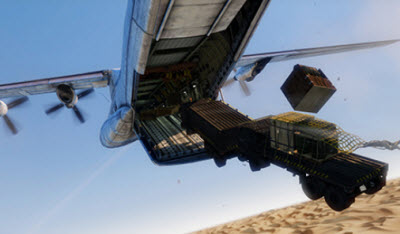 When he gets up on a barge and shoots, he has to take into account the motion of the water, which has the effect of throwing off your aim as you shoot. In that respect, it reminds me of Uncharted 2, when you have to deal with the physics of the train you’re riding as you try to take aim at enemies. This kind of game play and graphics combination takes advantage of the PlayStation 3’s Cell microprocessor, pretty much to the maximum degree possible.
When he gets up on a barge and shoots, he has to take into account the motion of the water, which has the effect of throwing off your aim as you shoot. In that respect, it reminds me of Uncharted 2, when you have to deal with the physics of the train you’re riding as you try to take aim at enemies. This kind of game play and graphics combination takes advantage of the PlayStation 3’s Cell microprocessor, pretty much to the maximum degree possible.
For the briefest of moments, you also have to try to shoot other rivals on a huge cargo plane, even as the back of the cargo plane opens and starts sucking everyone out. Drake has to dodge big crates that are sliding off the plane even as he tries to shoot at the enemies. The scene is a tour de force in graphics and physics.
Another cool scene, after the barge level, occurs when you’re scaling the side of a giant wrecked cargo ship, moving from one beam to the next, as enemies try to shoot down at you. You shoot upward and hit someone and they plummet to the ground right past year. Later, you have to fight on the side of a capsized ship. There, you have to avoid a flood of water as crazed enemies pursue you. Your horizontal axis turns vertical, as you have to hang on to a side of an open door to keep from falling down a corridor.
Only Naughty Dog considers staging gun battles in such places. They are defining moments in a game that really delivers a game-play experience that is like no other.
Annoyances
But there are plenty of annoying parts. One of them is that Drake is unbelievably indestructible for an everyday hero. His head gets slammed into a urinal: Drake suffers a slight bruise and a headache and is ready to brawl once again. He falls down as a floor collapses quite a few times. Then he gets up and shakes himself off. And he wanders aimlessly for days and nearly dies from lack of water, only to get a little bit of it and jump right back into a firefight. That’s fine for a video game. But it diminishes the realism around Drake’s everyman character. It’s like he goes from desert dehydration to Super Bowl readiness in an instant.
The No. 1 trade-off of all of the graphical beauty is speed and freedom of movement. When you have your gun drawn, it takes a full 11 seconds to spin around in a 360-degree circle. Eleven seconds! That means you can’t turn fast enough to shoot enemies who are coming at you from the side. You also can’t aim and turn fast enough to shoot an enemy who is running across your view. It’s really annoying when that enemy is running right to your side to take a close-and-personal shot at you. It should be the easiest thing in the world to shoot someone coming at you from the side, but it is the hardest.
The problem of having only two guns is that you don’t know which type of enemy you will face next. A Tau sniper pistol can penetrate the armor of any of the bosses, but it only has six shots. The Tau is a great prize to hang onto, but what if you also have an eight-shot grenade launcher as your big weapon? If the next scene has a host of enemies, you’re up the creek. But the good thing is that it almost always pays to take the rare weapon with you. You can shoot an enemy down and pick up a generic pistol or machine gun if you need a high-ammo gun.
One of the car chases in the game has Drake jumping from a running horse to a moving truck. That’s cool the first time you do it. But what about the next 10, as Drake tries to take down an entire caravan this way? The horse never gets tired.
Some of the boss fights are tough. But the super boss fights are annoyingly so. They get so repetitive that you start seeing the same battle animations over an over again. If I’m going to have a battle that has dozens of sequences to it, I want dozens of animations. Not five or six that are repeated ad nauseam.
Conclusion
The question becomes whether as a reviewer I should dock the game some points in my review score because of these annoyances, which if they go unmentioned will almost certainly wind up in Uncharted 4. I feel like I’ve collected a big bag of coins and have nowhere to put them. Yes, I’ve got to dock them. But we already rated Gears of War 3 at 92 and this game is a lot better than that one, in my opinion. So we’ll let Naughty Dog skate by with 91 out of 100. I honestly hope that the developers pay close attention and deal with some of the annoyances for Uncharted 4. Hopefully, by then, they’ll have some new Sony hardware to build it upon.
VentureBeat's mission is to be a digital town square for technical decision-makers to gain knowledge about transformative enterprise technology and transact. Learn More
